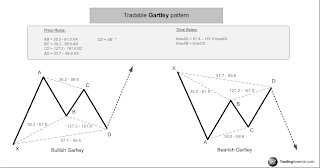Gartley 222 pattern
The Gartley 222 trading pattern was created by Harold M. Gartley, who first illustrated it in his book “Profits in the Stock Market” (1935). Gartley 222 pattern is reference to the page number on which the discussion about the pattern occurred.Gartley pattern & Elliott Wave Theory

Ideal Gartley pattern characteristic
Mr. Gartley draw the pattern and it’s market context/location. In the late 1980 In the book Profitable Patterns for Stock Trading Larry Pesavento assigned certain ratios to define the pattern precisely. He measured each price swing from peak to trough as a certain percentatge of the proceding price swing. Pesavento required these percentages to be Fibonacci ratios: 61.8, 78.6 100, 1.27, 1.618.Tradeable Gartley pattern characteristic
Problem is that it’s quite rare to see the Gartley pattern with exact precise Pesavento’s Fibonacci ratios. Some % delta or Fibo ranges must be used to expand the acceptable price swings ratios and produce more patterns, more trading opportunities. For example to allow XD retracement to be 57.7 till 88.6 rather than exactly 78.6.Continuation and Reversal Gartley position
H. M.Gartley defined only 1 proper market position for his pattern – at critical trend reversal point. Pesavento’s “Gartley” (ideal version) or extended “Gartley” happens of course more often and in different market conditions. One of the scenario important from the trading perspective is when the pattern is forming inside wave3. Wave3 inside wave3 is the strongest and most powerful market structure.We can also observe “Gartley” inside corrections periods when the swing following the pattern would be much smaller.
The point is that we can trade Gartleys (with original reversal position defined more than 70 years ago) and “Gartleys” (meeting Fibonacci equations) forming as trend continuation patterns.
Let's spot Gartley pattern
Enough teory for now. What at the end counts is that we look here at probably most powerfull and profitable price pattern forming on the charts. When you see its first 3 legs completed and forming swing CD crossing the point B price level - GET READY. Now your work starts.Mare sure you check also:
Construct PRZ (Potential Reversal Zone) for the Gartley pattern
Gartley pattern confirmation methods - trendlines
Gartley pattern confirmation methods - divergences
Gartley pattern confirmation methods - combining timeframes
Gartley pattern confirmation methods - reversal candlestick patterns
Gartley pattern confirmation methods - AB ?= CD
Gartley pattern confirmation methods - volatility
Gartley pattern confirmation methods - cycles
Gartley pattern 70-80 success ratio
Gartley pattern failure setups
Confirmation methods - more to come...



































